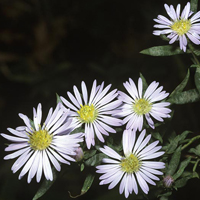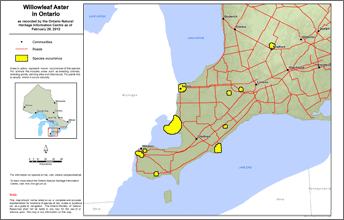Willowleaf aster
Scientific name: Symphyotrichum praealtum

Cover photo credit: Allen Woodliffe
Status
Threatened
“Threatened” means the species lives in the wild in Ontario, is not endangered, but is likely to become endangered if steps are not taken to address factors threatening it.
Date added to the Species at Risk in Ontario List
The Willowleaf aster was already assessed as threatened when the Endangered Species Act took effect in 2008.
What it looks like
The Willowleaf aster is a perennial herbaceous plant that blooms in autumn. It has a fairly smooth, waxy stem that can reach up to 1.5 metres in height. The small daisy-like flowers have pale blue-violet petals and a yellow centre that turns purple with age.
The upper leaves are narrow and grass-like with a few small teeth along the edge. The tiny seeds are scattered by the wind.
Where it lives
In Ontario, the Willowleaf aster is found in openings of oak savannahs, a very rare type of vegetation community containing many tallgrass prairie herbs and oak trees.
It has also been found along railways, roadsides and in abandoned farm fields.
Where it’s been found in Ontario
In Canada, the Willowleaf aster is believed to exist at about 12 locations in southwest Ontario, in Lambton, Essex and Middlesex Counties and the Municipality of Chatham-Kent. Additional populations may no longer exist.
The largest populations are in the greater Ojibway Prairie Complex of Windsor and on Walpole Island. The population size is unknown. The Willowleaf aster is common in the Midwestern United States.
View a larger version of this map (PDF)
What threatens it
The main threat to Willowleaf aster is habitat destruction due to habitat alteration, urban, and industrial development.
In the last 20 years, urban expansion has caused this rare plant to disappear from several sites where it was once found.
Action we are taking
Threatened Species and their general habitat are automatically protected.
Recovery strategy
A recovery strategy advises the ministry on ways to ensure healthy numbers of the species return to Ontario.
Read the executive summary (November 22, 2013)
Read the recovery strategy (November 22, 2013)
Government response statement
A government response statement outlines the actions the government intends to take or support to help recover the species.
Read the government response statement (December 15, 2014)
Review of progress
A review of progress made toward protecting and recovering a species is required no later than the time specified in the species’ government response statement, or not later than five years after the government response statement is published if no time is specified.
Read the report on progress towards the protection and recovery of 16 species at risk, including Willowleaf aster (Symphyotrichum praealtum) (2019).
Habitat protection
General Habitat Protection - June 30, 2013
What you can do
Report a sighting
Report a sighting of an endangered animal or plant to the Natural Heritage Information Centre. Photographs with specific locations or mapping coordinates are always helpful.
Volunteer
Volunteer with your local nature club or provincial park to participate in surveys or stewardship work focused on species at risk.
Be a good steward
- Private land owners have a very important role to play in species recovery; if you find Willowleaf aster on your land, you may be eligible for stewardship programs that support the protection and recovery of species at risk and their habitats.
- Invasive species seriously threaten many of Ontario’s species at risk; to learn what you can do to help reduce the threat of invasive species, visit:
- Pollinators, such as bees, are in steep decline across the globe and they play a key role in the survival of many of Ontario’s rare plants. For information on how you can help scientists monitor pollinator populations in Ontario visit Seeds of Diversyty.
- Willowleaf aster and many other species at risk depend on healthy grassland prairies, a rare habitat in Ontario; learn more about these habitats, the species that depend on them, and what you can do to help.
Report illegal activity
Report any illegal activity related to plants and wildlife to
Quick facts
- Aboriginal people used Willowleaf aster to treat stomach aches and injuries; they also smoked the dried leaves for good luck while hunting.
- The Willowleaf aster is much more common in the United States, where it provides nectar (an important food source) for migrating Monarch butterflies.
- The seed produced by the Willowleaf aster has a low germination rate, but the plant is very successful in spreading by underground roots called rhizomes; in fact, many clusters of this plant, with sometimes 100 or more stems each, may actually be a single plant.
